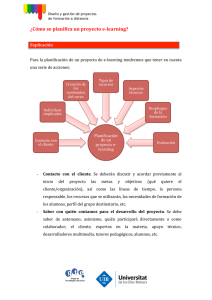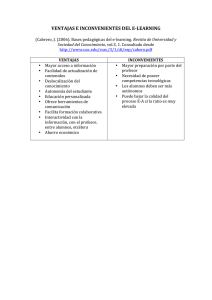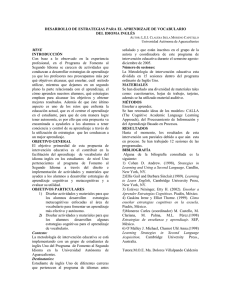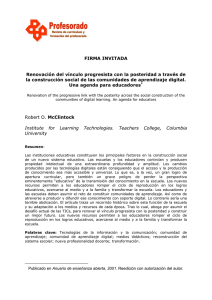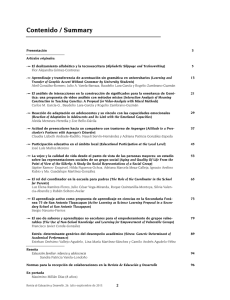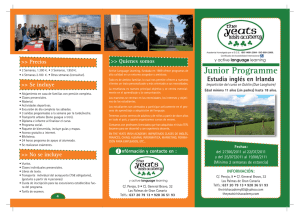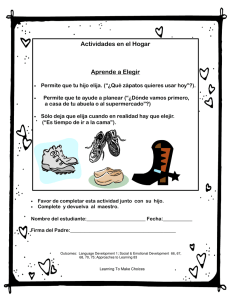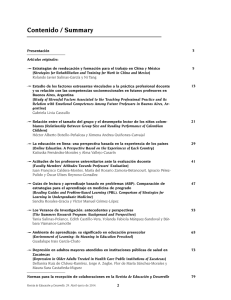(CALL) / Computer Assisted Language Learning
Anuncio
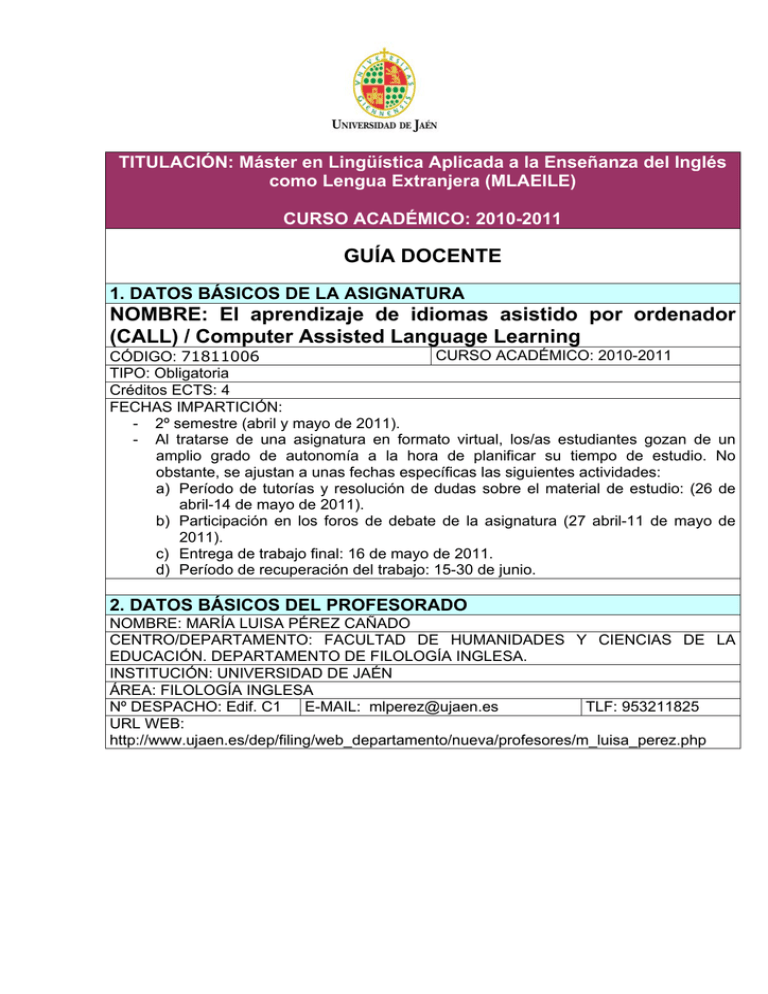
TITULACIÓN: Máster en Lingüística Aplicada a la Enseñanza del Inglés como Lengua Extranjera (MLAEILE) CURSO ACADÉMICO: 2010-2011 GUÍA DOCENTE 1. DATOS BÁSICOS DE LA ASIGNATURA NOMBRE: El aprendizaje de idiomas asistido por ordenador (CALL) / Computer Assisted Language Learning CURSO ACADÉMICO: 2010-2011 CÓDIGO: 71811006 TIPO: Obligatoria Créditos ECTS: 4 FECHAS IMPARTICIÓN: - 2º semestre (abril y mayo de 2011). - Al tratarse de una asignatura en formato virtual, los/as estudiantes gozan de un amplio grado de autonomía a la hora de planificar su tiempo de estudio. No obstante, se ajustan a unas fechas específicas las siguientes actividades: a) Período de tutorías y resolución de dudas sobre el material de estudio: (26 de abril-14 de mayo de 2011). b) Participación en los foros de debate de la asignatura (27 abril-11 de mayo de 2011). c) Entrega de trabajo final: 16 de mayo de 2011. d) Período de recuperación del trabajo: 15-30 de junio. 2. DATOS BÁSICOS DEL PROFESORADO NOMBRE: MARÍA LUISA PÉREZ CAÑADO CENTRO/DEPARTAMENTO: FACULTAD DE HUMANIDADES Y CIENCIAS DE LA EDUCACIÓN. DEPARTAMENTO DE FILOLOGÍA INGLESA. INSTITUCIÓN: UNIVERSIDAD DE JAÉN ÁREA: FILOLOGÍA INGLESA Nº DESPACHO: Edif. C1 E-MAIL: [email protected] TLF: 953211825 URL WEB: http://www.ujaen.es/dep/filing/web_departamento/nueva/profesores/m_luisa_perez.php 3. PRERREQUISITOS, CONTEXTO Y RECOMENDACIONES PRERREQUISITOS: No se establecen prerrequisitos especiales. CONTEXTO DENTRO DE LA TITULACIÓN: La materia, incluida en el módulo I (“Lingüística Aplicada a la Enseñanza de Lenguas”), tiene como objetivo adentrar a los/as estudiantes en el conocimiento de las nuevas tecnologías aplicadas a la enseñanza y aprendizaje del inglés como lengua extranjera, proporcionando tanto una aproximación teórica al uso de estos nuevos recursos como oportunidades para su aplicación práctica. Dado que los/as alumnos/as del Máster tienen un perfil profesional orientado a la docencia y que en el contexto actual las nuevas tecnologías han dejado de concebirse como un complemento adicional para pasar a ser un recurso docente fundamental en el aula, la asignatura tiene una gran utilidad para su futuro desempeño como profesores/as de lenguas extranjeras. RECOMENDACIONES Y ADAPTACIONES CURRICULARES: Aunque la modalidad de impartición de la asignatura es virtual y, por lo tanto, los/as alumnos/as disponen de una mayor libertad y flexibilidad para gestionar su tiempo de estudio, se recomienda la participación activa en los foros de debate dentro de las fechas propuestas, puesto que supondrá un 20% de la calificación final. 4. COMPETENCIAS Y RESULTADOS DE APRENDIZAJE Código I4 I5 S16 P9 P14 S24 S25 E33 Resultado 1 Resultado 2 Resultado 3 Resultado 4 Denominación de la competencia Conocimiento de una lengua extranjera Conocimientos de informática relativos al ámbito de estudio Aprendizaje autónomo Trabajo en equipo Razonamiento crítico Capacidad de aplicar los conocimientos teóricos en la práctica Uso de internet como medio de comunicación y fuente de información Comprensión de los nuevos ámbitos del conocimiento Resultados de aprendizaje Consolidar el conocimiento del inglés académico a nivel escrito Ser capaz de aplicar conocimientos informáticos previos al ámbito de la enseñanza y aprendizaje de lenguas extranjeras, así como al diseño de materiales didácticos Ser capaz de programar con eficacia el plan de estudio de una materia dentro de una modalidad de enseñanza-aprendizaje virtual Ser capaz de negociar e intercambiar ideas sobre diferentes aspectos de la materia en un foro de debate virtual Resultado 5 Resultado 6 Desarrollar la capacidad para el uso de internet como un recurso de intercambio de ideas sobre diferentes prácticas docentes. Ser capaz de aplicar el marco teórico sobre las nuevas tecnologías informáticas a la práctica docente, explotando las potencialidades de internet como fuente de recursos docentes en diferentes contextos educativos. 5. CONTENIDOS UNIT 1: Educational Technology 1.1 Introduction 1.2 Behaviouristic CALL 1.3 Communicative CALL UNIT 2: CD-ROMS UNIT 3:The Internet 3.1 What is it? 3.2 The history of the Internet 3.3 Internet Services 3.3.1 Electronic mail (or e-mail) 3.3.2 Internet Relay Chat (IRC) 3.3.3 Discussion lists 3.3.4 News groups 3.3.5 World Wide Web (WWW or simply Web) UNIT 4: CALL in the EFL Context 4.1 Some external features of CD-ROMs 4.1.1 User interface 4.1.2 Navigation 4.1.3 Learning aids 4.2 Rationale for using multimedia UNIT 5: Using Multimedia Applications in the EFL Classroom 5.1 Evaluating and selecting software and resources 5.1.1 A brief look at research 5.1.2 Features to take into account 5.2 Introducing learners to multimedia applications 5.2.1 Developing user-support materials 5.3 Multimedia applications as self-access resources 5.3.1 Accommodating individual needs 5.4 Integration of multimedia applications in the classroom curriculum 5.4.1 Lesson planing 5.4.2 Collaborative learning UNIT 6: Using E-mail in the EFL Classroom 6.1 Using e-mail in the EFL classroom 6.1.1 Netiquette 6.2 E-mail and learning UNIT 7: Implications of CALL IN THE EFL Classroom 7.1 Learner autonomy 7.2 Teachers' roles 7.2.1 The teacher as researcher, framer and facilitator 7.2.2 The teacher as tutor 7.2.3 The teacher's responsibility for the social/affective dimension in the classroom 7.2.4 The teacher's pedagogical beliefs 7.3 Students' roles 7.3.1 Active learning 7.3.2 Constructive learning 7.3.3 Collaborative learning 7.4 Final summing up 7.5 Useful EFL websites 6. METODOLOGÍA Y ACTIVIDADES ACTIVIDADES Estudio del material de la asignatura y resolución de dudas (período de tutorías) Debate en el foro virtual Realización de un ensayo escrito TOTALES: HORAS PRESENCIALES HORAS DE TRABAJO AUTÓNOMO TOTAL DE HORAS CRÉDITOS ECTS COMPETENCIAS (Códigos) - 20 20 0,8 I4, I5, S16 - 30 30 1,2 I4, S24, P9, P14 - 50 50 2 I4, S24, P14, S25, S33 - 100 100 4 7. SISTEMA DE EVALUACIÓN ASPECTO CRITERIOS - Participación en los debates virtuales programados - Realización del trabajo escrito - - Grado de participación. Implicación activa en los temas de debate propuestos. Grado de interacción con los/as compañeros/as en el foro virtual. Originalidad de las contribuciones al debate. Adecuación al tema propuesto. Claridad estructural. Corrección gramatical. Riqueza léxica. Uso de un registro académico. Aplicación de la terminología específica estudiada en la materia. Uso adecuado de referencias bibliográficas. Originalidad y espíritu crítico. INSTRUMENTO PESO Observación y notas de los profesores 20% 1 trabajo (con opción a hacerlo de forma individual o en parejas) 80% El sistema de calificación se regirá por lo establecido en el RD 1125/2003 de 5 de septiembre por el que se establece el sistema europeo de créditos y el sistema de calificaciones en las titulaciones universitarias de carácter oficial. 8. DOCUMENTACIÓN/BIBLIOGRAFÍA ESPECÍFICA o BÁSICA: UNIT 1: EDUCATIONAL TECHNOLOGY Carter, R. & Nunan, D. (2001): The Cambrige Guide to Speakers of Other Languages. Cambridge: Cambridge University Press. Chapter 15. Chapelle, C. (2001): Computer Applications in Second Language Acquisition: Foundations for Teaching, Testing and Research. Cambridge: Cambridge University Press. UNIT 3: THE INTERNET Andrieu, O. (1997): Cómo buscar y encontrar en Internet. Barcelona: Ediciones Gestión 2000, S.A. Cooper, B.; Coath, N.; Milner, A.; Burrows, T. & Mann, T. (1997): Internet. Barcelona: Ediciones B. Sperling, D. (1997): The Internet Guide for English Language Teachers. London: Prentice Hall. UNIT 4: CALL IN THE EFL CONTEXT Brett, P. A. (1995): Making a CD-ROM. CALL Review. March, 3-5. Sorge, D. H.; Russell, J. D. & Weilbeaker, G. L. (1994): "Implementing Multimedia-Based Learning". In Reisman, S. (ed.) (1994). Multimedia Computing. London: Idea Group, pp. 506-535. UNIT 5: USING MULTIMEDIA APPLICATIONS IN THE EFL CLASSROOM Hardisty, D. & Windeatt, S. (1989): CALL. Oxford: Oxford University Press. Squires, D. & McDougall, A. (1997): Cómo elegir y utilizar software educativo. Madrid: Ediciones Morata. It is also available in English: Choosing and Using Educational Software. Taylor & Francis. Sheerin, S. (1989): Self-Access. Oxford: Oxford University Press. UNIT 6: USING E-MAIL IN THE EFL CLASSROOM Bauman, J. (1998): "Using E-Mail with your students". The Language Teacher Online. http://langue.hyper.chubu.ac.jp/jalt/pub/tlt/98/Feb/bauman.html Carter, R. & Nunan, D. (2001): The Cambrige Guide to Speakers of Other Languages. Cambridge: Cambridge University Press. Chapter 30. UNIT 7: IMPLICATIONS OF CALL IN THE EFL CLASSROOM Dudeney, G. (2000): The Internet and the Language Classroom. Cambridge: Cambridge University Press. Jonassen, D. H. (1995): "Supporting Communities of Learners with Technology: A Vision for Integrating Technology with Learning in Schools" in Educational Technology. July-August, pp. 60-63. Ruschoff, B. (1993): "Language Learning and Information Technology: State of the Art". CALICO Journal, 10:3, 5-17. Teeler, D. & Gray, P. (1999): How to Use the Internet in ELT. Harlow: Longman. GENERAL y COMPLEMENTARIA : Ahmed, K.; Corbett, G.; Rogers, M. & Sussex, R. (1985): Computers. Language Learning and Teaching. Cambridge: Cambridge University Press. Allwright, D. & Bailey, K. M. (1991): Focus on the Language Classroom. Cambridge: Cambridge University Press. Barnett, L. (1993): "Teacher off: computer technology, guidance and self-access. System, 21, pp. 295-304. Berge, Z. L. (1996): "The role of the Online Instructor/Facilitator". Online document. Bosch, M. (1996): Autonomia i Aprenentatge de Llengües. Barcelona: Editorial Graó. Brett, P. A. (1995): "Making a CD-ROM". CALL Review. March, 3-5. Chun, D. M. (1994): "Using Computer Networking to Facilitate the Acquisition of Interactive Competence" in System, 22/1: 17-31. Dickinson (1987): Self-Instruction in Language Learning. Cambridge: Cambridge University Press. Doughty, G. (et al.) (1995). Using Learning Technologies: Interim Conclusions from the TILT Project. Glasgow: University of Glasgow Press. Duchastel, P. (1996): "Learning Interfaces". In Liao, T. (ed.), Advanced Educational Technology: Research Issues and Future Potential. New York: Springer-Verlag. Ely, D. P. & Plomp, T. (1986): "The Promises of Educational Technology: a Reassessment". International Review of Education, 32: 231-250. Fernandes, J.; Ellis, G. & Sinclair, B. (1990): "Learner training: Learning how to learn". In Crookall, D. & Oxford, R (eds.) Simulation, Gaming, and Language Learning. Boston, MA: Newbury House/Heinle & Heinle. Gagne, R. M. & Briggs, L. J. (1979): Principles of instructional design. (2nd ed.) New York: Holt, Rinehart & Winston. Garrett, N. (1991): "Technology in the service of language learning: trends and Issues". The Modern Language Journal, 75/1: 74-101. Healey, D. & Johnson, N. (1998): "A place to start in selecting software". CAELL Journal, 8/1, Winter. Holec, H. (1980): Autonomy and Foreign Language Learning. Council of Europe. Holec, H. (ed.) (1988): Autonomy and Self-Directed Learning. Present Fields of Application. Project 2, Council of Europe. Hoofman, R. (1994): "Powerful, personal: electronic mail and the L2 writing process" in ReCALL, 6/2: 53-62. Hueyching, J. J. & Reeves, C. R. (1992): "Mental Modes: a Research Focus for Interactive Learning Systems". Educational Technology Research & Development, 40/3: 39-53. Ivy, M. (1998): "Activities for using junk email in the ESL/EFL classroom". The Internet TESL Journal, 4/5, May 1998. http://www.aitech.ac.jp/~iteslj/ Jolicoeur, K. & Berger, D. E. (1988): "Implementing Educational Software and Evaluating its Academic Effectiveness: Part II". Educational Technology, 28/10: 13-19. Jonassen, D. H. (1995): "Supporting Communities of Learners with Technology: A Vision for Integrating Technology with Learning in Schools" in Educational Technology, July-August: 60-63. Keegan, D. (1996): Foundations of Distance Education. London: Routledge. Kinzie, M. B. (1990): "Requirements and Benefits of Effective Interactive Instruction: Learner control, self-Regulation, and Continuing Motivation". Educational technology Research & Development, 38: 179-211. Kozma, R. B. (1991): "Learning with media". Review of Educational Research, 61: 179-211. Microsoft Corporation (1995): Encarta Lesson Collection. Morrison, B. & Fitzgerald, S. (1996): "Integrating CD-ROM programs into a language learning environment". Paper initially presented at MELTA '96, Penang, Malaysia. Oliver, R. & Perzylo, L. (1992): "An investigation of Children's Use of a Multimedia CDROM Product for Information Retrieval". Microcomputers for Information Management, 9:4, pp. 225-239 Oskarsson, M. (1988): Approaches to self-Assessment in Foreign Language Learning. London: Pergamon Press Perzylo, L. (1993). The Application of Multimedia CD-ROMs in Schools. British Journal of Educational Technology, 24, 3, 191-197. Phillips, M. (1995): "Educational Technology in the Next Decade: an ELT Perspective" in C. Brumfit, M. Phillips & P. Skehan (eds.), Computers in English Language Teaching. Oxford: Pergamon Press. Phillips, M. (1996): "CALL in its educational context" in G. Leech & C. N. Candlin (eds.), Computers in English Language Teaching and Research. London: Longman. Ragsdale, R.G. & Kassam, A. (1994): "The Magic of Multimedia in Education". In Reisman, S. (ed.), Multimedia Computing. London: Idea Group. pp. 558-594. Roblyer, M. D. (1985): "The Greening of Educational computing: a Proposal for a more Research-Based Approach to Computers in Instruction". Educational Technology, 25/1: 40-44. Rohfeld, R. W. & Hiemstra, R. (1995): "Moderating discussions in the electronic classrom". In Berge, Z. & Collins, M., Computer Mediated Communication and the Online Classroom. Distance Learning, 3: 91-104. Cresskill NJ: Hampton Press. Ruschoff, B. (1993): "Language Learning and Information Technology: State of the Art". CALICO Journal, 10/3: 5-17. Schank, R. C. & Cleary, C. (1995): Engines for Education. Hillsdale, NJ: Lawrence Erlbaum Associates. Sheerin, S. (1989): Self-Access. Oxford: Oxford University Press. Sorge, D. H.; Russell, J. D. & Weilbeaker, G. L. (1994): "Implementing Multimedia-Based Learning". In Reisman, S. (ed.) (1994). Multimedia Computing, pp. 506-535. London: Idea Group. Sperling, D. (1997): The Internet guide for English language Teachers. London: Prentice Hall. Thorn, W. J. (1995): "Points to consider when evaluating interactive multimedia". The Internet TESL Journal, II/4. Underwood, J. (1984): Linguistics, computers, and the language teacher: A communicative approach. Rowley, MA: Newbury House. Warschauer, M. (1996): Computer-assisted language learning: An introduction. In S.fotos (ed.), Multimedia language teaching, pp. 3-20. Tokyo: Logos International. Wenden, A. & Rubin, J. (1987): Learner strategies in Language Learning. London: Prentice Hall.
